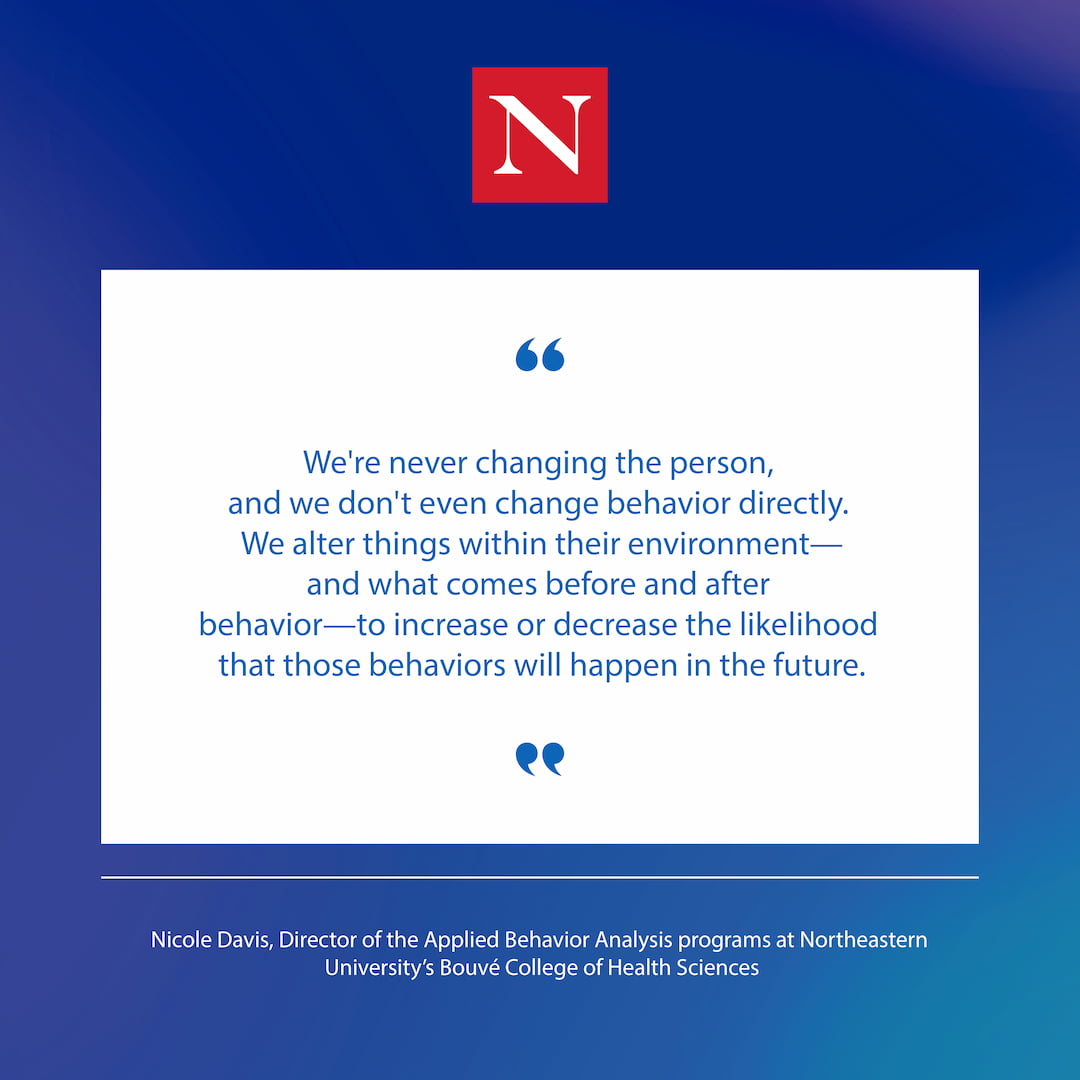Despite the growing success experts are seeing in the field of applied behavior analysis (ABA), there is still a lingering skepticism that plagues the use of its methods. Most of these doubts are rooted in a surface-level understanding of ABA or misconceptions that are a result of a problematic past.
Despite ABA’s troubling past, the field has experienced exponential growth since 2016. According to a recent government report, there has been 113 percent growth in the number of ABA program offerings in the United States, and a 249 percent growth in degree completions.

Here’s an overview of what applied behavior analysis really is, what behavior analysts do, and why this field is important.
What Is Applied Behavior Analysis?
Applied behavior analysis is a natural science approach to understanding and remediating behavior problems deemed “socially significant.” According to Andrew Bonner, director of the Master of Science in Applied Behavior Analysis program at Northeastern University’s Charlotte campus, “it’s the application of the principles of behavior to improve behavior problems that are important to society.”
He breaks this definition down even further, speaking to the specific target of each word. The formal term, applied behavior analysis, is defined as follows:
- Applied: Behavior problems that society identifies as important because their remediation stands to enrich the lives of our clients
- Behavior: Anything an organism does
- Analysis: Evaluation of whether the affected changes are a result of the intervention, as opposed to different factors
Interested in an Applied Behavior Analysis Career?
Learn how an ABA degree can give you the skills you need to make a difference in the lives of others.
Common Techniques
All ABA professionals, no matter where they work, assess behavior. They look at why a behavior occurs and then utilize those data to make evidence-based, data-driven decisions about how to intervene.
Behavior analysts have a wide variety of strategies and tactics at their disposal to aid in successful treatment plans. These techniques, for both individuals and groups, include:
- Positive reinforcement: Strengthening behavior that society wants to see more of
- A-B-C method: Analyzing the antecedent (what happens immediately before the behavior occurs), the behavior (what the organism does), and the consequence (what happens directly after the behavior), to determine in which context certain behaviors are most probable
- Pivotal response training: Changing one behavior to affect subsequent behaviors
- Discrete trial training: Prompting the occurrence of a specific behavior and then delivering a reinforcer when that behavior occurs
- Task analysis: Taking a complex behavior and breaking it down into smaller parts to then reinforce each component of the overall sequence of the total behavior
Common Misconceptions
It’s no secret that ABA has a problematic history. However, through research and social progressions, ABA has evolved away from its controversial roots. Despite this evolution, the ABA field still combats these negative interpretations. Here are a few examples of common ABA misconceptions that are no longer applicable to the field today.
Modifies Behavior
Since ABA has historically been linked with behavior modification, it’s often assumed that they’re the same thing. However, whereas behavior modification intervenes upon behavior without understanding why that behavior occurs, ABA takes special care to understand the determinants of a given behavior prior to intervention. As a result, ABA interventions are tailored to each learner which improves their effectiveness.
Nicole Davis, the director of the Applied Behavior Analysis programs at Northeastern University’s Bouvé College of Health Sciences, confirms that “we’re never changing the person, and we don’t even change behavior directly.” It’s meant to alter a client’s environment to help them address problems they want to solve. Davis continues to explain that “we’re looking at why a behavior occurs, and then utilizing that to build plans that are individualized to whoever our client is so that it works for them.”

“Fixes” People with Autism
There’s an abundance of misunderstandings around ABA’s purpose in assisting those with developmental disabilities, such as autism. One of the biggest is that it’s meant to force the ASD community to conform to societal expectations and standards. This framework implies that autism is something that needs to be fixed.
ABA is an evidence-based approach that doesn’t “fix,” but rather, and for example, helps individuals with developmental disabilities learn how to extract more value from the world around them. According to the Behavior Analyst Certification Board (BACB) website, ABA helps address behaviors that limit residential, educational, or vocational options. Often, this involves teaching behaviors society deems important, but not societal expectations.
“Everything we do is individually based on the goals of the clients that we serve. We never just begin behavior analytic services without understanding ‘what do you want out of this experience and how can our services enrich your life in ways that are consistent with your own vision for your life?,’” says Bonner.
Only Makes Caregivers’ Lives Easier
Another misconception is that ABA is just intended to help families of people who identify as autistic manage various challenges. While ABA does often involve supporting families of children with developmental disabilities, it’s not leveraged to force a child to comply with their parents’ instruction.
Today, ABA services focus on various factors of independent living. This includes helping individuals with autism learn basic life skills that might be more challenging for them, such as hygiene. It’s important to remember that autism is a spectrum, therefore some individuals with autism have greater challenges than others. This can result in self-harming behaviors that can be incredibly damaging. In those situations, ABA is intended to help address these problematic behaviors by teaching individuals alternative ways to communicate without engaging in such behaviors.
Only Addresses Autism
ABA is an evidence-based approach to helping people with behavioral challenges, such as those with ASD, learn new skills. However, it has many uses outside of developmental disabilities. Just over 71 percent of BCBAs use ABA methods to help individuals with ASD, while other professionals help individuals struggling with other challenges. In some situations, it’s also used to address problematic behaviors in geriatric populations, in the workplace, and even as a way to reduce greenhouse gas emissions. As Davis puts it, “neither ‘A’ in ‘ABA’ stands for autism.”
Uses Punishment-Based Methods
While ABA is often associated with punishment, the reality is that punishment is used as an absolute last resort in the field. “Some behavior analysts might go their entire career never using a punishment procedure,” says Bonner. The Ethics Code for Behavior Analysts instructs BCBAs to continuously evaluate and document the results of any punishment-based or restrictive procedures, and discontinue them in a timely manner if they aren’t proven effective. According to Bonner, “oftentimes, if you use other procedures effectively and you really take time to assess the variables underpinning behavior problems, you will not need to use punishment as a procedure.”
Trains People to Comply with Instruction
Another common perception of ABA is that it simply trains people to comply with instruction without question. “Some long-standing misconceptions are that we just train people to comply with our instructions . . . without necessarily factoring in the preferences and the autonomy of the individual to choose what they want,” says Bonner. ABA isn’t meant to decrease autonomy, but rather boost it by helping individuals manage behavior patterns they’re hoping to improve.
What Does a Behavior Analyst Do?
Most behavior analysts work directly with people who are a part of vulnerable populations, including children with and without developmental disabilities, elderly and geriatric communities, and commonly marginalized groups.
The most well-known group of individuals that ABA professionals help is children and adults diagnosed with autism spectrum disorder. Behavior analysts can assist with social skills development and teach clients how to improve their daily life. Even individuals with other disorders, such as obsessive-compulsive disorder, can benefit from working with a behavior analyst.
However, behavior analysts work in a wide variety of sectors including health, fitness and sports, education, and business. For example, oil rigs have proven to be hazardous places to work. If a mistake is made, it can cost someone their life. Behavior analysts are tasked with the responsibility to reduce the likelihood of employee injury and death in these situations by manipulating an aspect of the environment to make their job safer.
Behavior analysts help their clients by observing behaviors, developing a customized and sustainable intervention plan, and implementing that plan successfully. Other responsibilities include meeting with and training caregivers, collecting data from various sources, and looking at clients’ surroundings to better understand their behavior patterns.
There are four levels of behavior analyst certifications:
- Registered Behavior Technician (RBT): High school level
- Board-Certified Assistant Behavior Analyst (BCaBA): Bachelor’s level
- Board-Certified Behavior Analyst (BCBA): Master’s level
- Board-Certified Behavior Analyst – Doctoral: Doctoral level
Common Mistakes
Like any medical profession, behavior analysts have a set of ethical guidelines they must adhere to. Ignoring or defying these guidelines is a frequent mistake that some behavior analysts commit that can result in removing credentials, jeopardizing the wellbeing of clients, and negatively impacting the reputation of the field.
Another common, and damaging, mistake made by behavior analysts early in their career is thinking a degree provides all the information they need to be successful. “Now that they’ve done grad school,” Bonner explains, “young behavior analysts often ignore what’s happening in the field. They stop learning.” This can lead to behavior modifying—trying different intervention methods rather than observing behavior patterns first.
Despite the valuable knowledge a graduate-level degree offers, behavior analysts must pay close attention to what’s happening in the field, consistently reviewing academic journals, industry requirements, and newly developed standards. Starting to practice with clients is just that—a practice that needs to be honed and constantly improved.
Why Is Applied Behavior Analysis Important?
Within the last few decades, ABA professionals have helped vulnerable individuals in ways other practitioners haven’t been able to. In recent years, however, these principles have proven effective in improving the lives of anyone. “I frequently joke that if insurance paid for it, I would go to a behavior analyst,” says Nicole Davis, director of Northeastern University’s Applied Behavior Analysis programs.
As a result, there has been a focus on the “applied” aspect of ABA, identifying the behavior problems that society thinks are important. Why are these behaviors important to society? “These behavior problems are impacting the quality of life of citizens in society,” says Bonner. “Therefore, our mandate is to improve peoples’ quality of life through evidence-based and behaviorally oriented strategies.”
Consider Applied Behavior Analysis
The field of applied behavior analysis is an exciting field with a growing need for well-educated, passionate professionals to join its mission to improve individuals’ quality of life. If you’re interested in helping improve others’ lives, consider a degree in applied behavior analysis.

According to a government report, around 67 percent of ABA professionals have a master’s degree, with four percent holding post-graduate certifications or doctoral degrees. In order to become a leader in the field, enrolling in a program, like Northeastern’s Master of Science in Applied Behavior Analysis, provides students in-depth instruction, a valuable advanced degree, and an easy pathway to certification in becoming a Board-Certified Behavior Analyst. This will give students the necessary tools to start an exciting career in applied behavior analysis as soon as possible.
Want to learn more about how ABA is changing the world of behavior analysis? Check out Northeastern’s Master of Science in Applied Behavior Analysis program page.







Related Articles
4 Pressing Global Health Problems We Face Today
Global Health Careers: How Can I Make a Difference?
Compliance Specialists: Who They Are and What They Earn